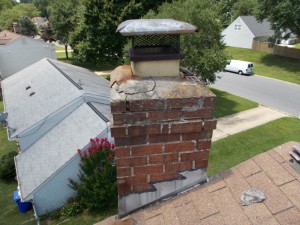Your chimney endures a lot of abuse through the winter months: The heat and smoke from your fires, freezing temperatures and rain, snow, ice and sleet. It’s easy to forget about your chimney once warmer weather hits, but it’s important to be on the lookout for signs of water leaks during the spring and summer months.
Damage caused by a leaking chimney
Water poses a major hazard to your chimney, fireplace and your home. Water leaking into and around your chimney can cause rusted dampers, grates and doors in your fireplace. It can deteriorate your chimney or firebox masonry, cause staining on your chimney’s masonry or lead to a cracks, missing or deteriorated mortar joints between the clay flue tiles. If the water leaking from your chimney gains access to your home’s structure, it can discolor your walls or wall coverings, cause sagging ceiling or wallboard, or rot the wood supports of your home’s structure. Water in your chimney also can react with the creosote inside, filling your home with an unpleasant smell during the warm summer months.
Signs of water leaks
Because water can be so damaging to your chimney, it’s important to be on the lookout for signs that water is making its way into your chimney and fireplace system. Some signs are more obvious, while others are relatively subtle. Water pooling in the bottom of your fireplace is a clear indication that water is getting into your chimney. You also may notice rusting in your fireplace components. On the exterior of your home, cracked bricks or crumbling mortar can be a clear sign of water damage. Vegetation growth on the brick such as mold,mildew and algae can be observed. A less obvious sign is discoloration on your chimney’s bricks. Often, if water is penetrating chimney masonry, there will be whitish staining down the sides of the chimney bricks, this is called efflorescence.
Causes of water leaks
If water is leaking into your chimney, there are many possible culprits. A loose, displaced, damaged or missing chimney cap can allow water to pour down the insides of your chimney flue, causing a major problem. Cracked or deteriorated chimney crowns also can fail to direct water away from your flue and allow water to flow into your chimney. At the base of your chimney, where it meets the roof, there’s a protective flashing meant to seal the gap. That flashing can crack, corrode or develop holes, which means it will fail to prevent water from leaking in around the base of the chimney. Also if you have a large chimney the absence of a chimney cricket can allow water pool and not be properly diverted away from the base of the chimney.
Ways to prevent spring water damage
As with most things, when it comes to a leaking chimney, an ounce of prevention is worth a pound of cure. One of the best ways to prevent water damage in your chimney is to inspect your chimney for signs of water damage each spring. Spring can be a great time for your annual chimney sweeping and inspection, always have a professional sweep inspect your chimney,they inspect the chimney crown, cap and flashing for signs of deterioration that could lead to leaks. The sweep also will look for early signs of water leaks so you can fix the leak before it leads to major damage.
If you have noticed signs of water damage, or if you want to schedule your spring chimney inspection, call Clean Sweep of Anne Arundel County to schedule and appointment today!

